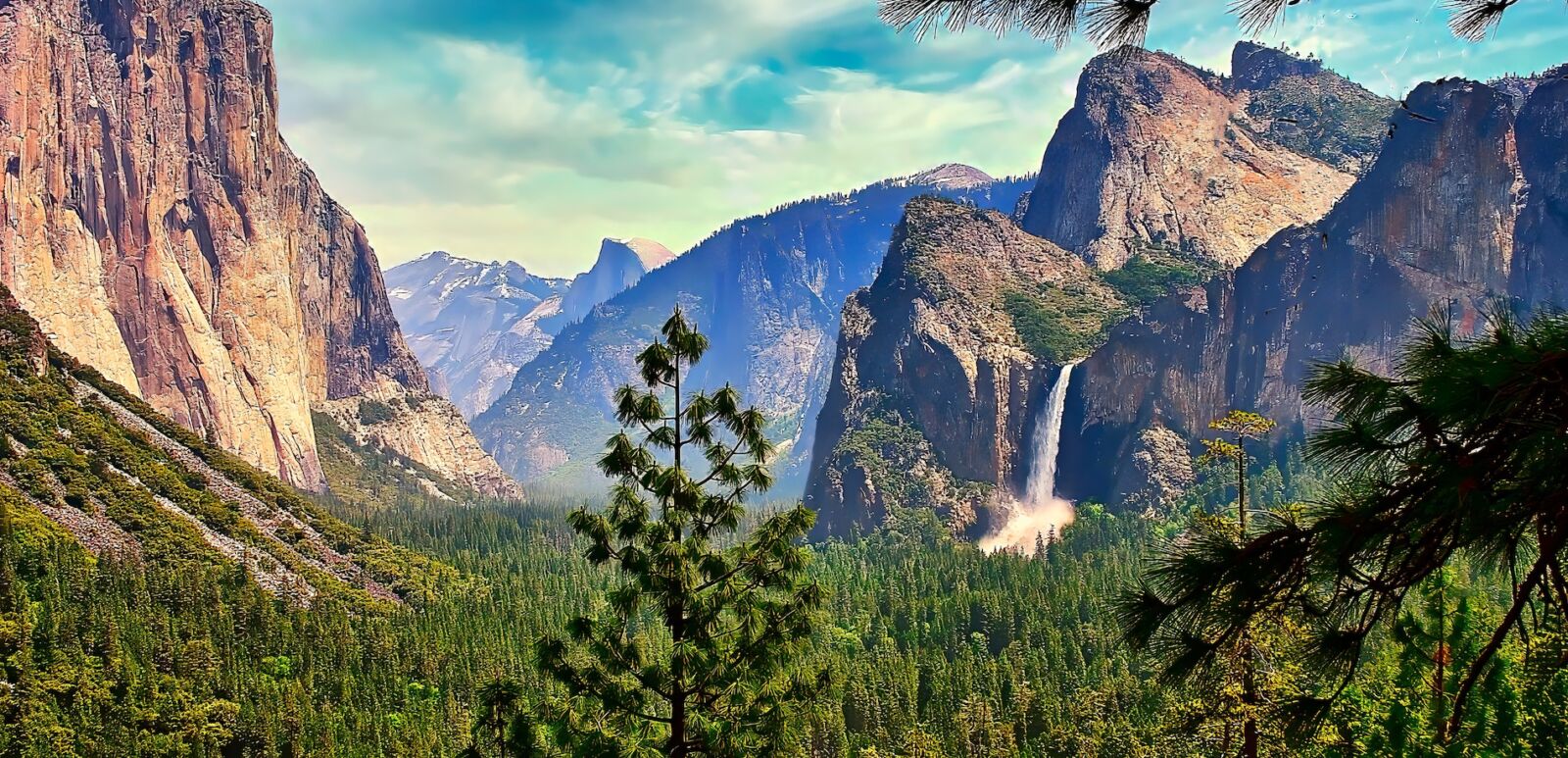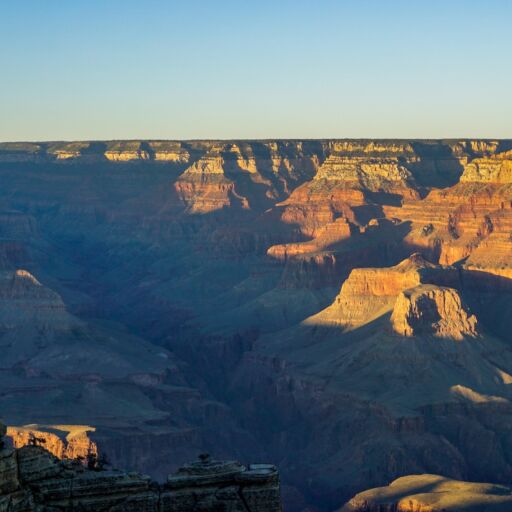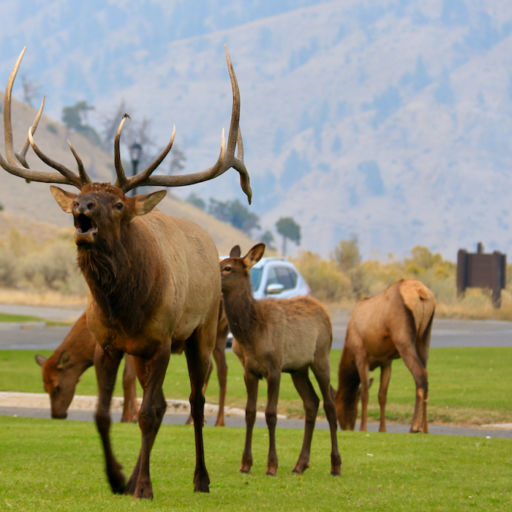You’re going to Yosemite National Park and you’ve heard you should check out the waterfalls. Beyond that, you have no plan? We got you. Here’s what you need to know to take in all of Yosemite’s majestic, high-cascading waterfalls.
The short version: Spring time, after the snow melts, is the best time to take in and appreciate one or all of the falls. Some waterfalls are completely dry by August, so taking a tour of the park in May or June is the best time to see them at their full strength.
What to Know About Yosemite National Park
Yosemite was the foundation of the national parks movement and became officially protected in 1864. The park is popular year round for an obvious reason — it’s gorgeous. Everything from the dramatic granite cliffs to the deep valleys, flowing rivers, 3,000-year-old Sequoias and a thousand other things to see.
Known among rock climbers for El Capitan, the tallest granite monolith, Yosemite is roughly the size of Rhode Island and hosts the tallest waterfall in North America, Yosemite Falls. Entering the park provides striking views of Half Dome when visitors pass through Wawona Tunnel. Other activities besides rock climbing and hiking include camping, river rafting, interpretive history and cultural centers, many guided ranger programs and even ice skating in the winter.
If you’re exploring National Parks, check out our guide to all 63 National Parks.
The Significance of Waterfalls in Yosemite
Waterfalls are one of Yosemite’s most popular draws and Yosemite National Park is home to thousands of waterfalls, many of which can be seen from the popular Yosemite Valley.
Major Waterfalls in Yosemite
Yosemite Falls
Yosemite Falls is the sixth tallest waterfall in the world at 2,425 feet and as previously mentioned, the highest waterfall in North America. There are three sections of the fall and it is visible from numerous places in Yosemite Valley including the Yosemite Chapel, the Yosemite Valley Lodge and many other hiking trails.
Viewing the waterfall at the peak in early spring is awe-inspiring. There is water from November to July, but expect August and early fall to be potentially completely dry. You can visit Yosemite Falls and get up close via a one mile wheelchair and stroller accessible trail. Expect to get a little wet in the spring. For the strong hiker, a strenuous hike aptly named Yosemite Falls Trail is also a memorable experience.
Upper Yosemite Fall
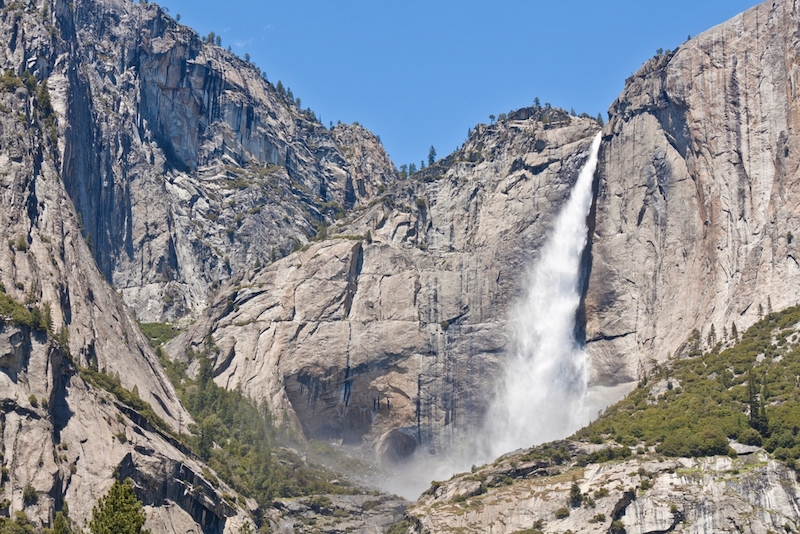
This section of Yosemite Fall is the largest at 1,430 feet and is visible from many places in the park. Trails from the valley floor and other park areas lead to the top and bottom of the Upper Yosemite Fall.
Middle Cascades
This section is only 675 feet and not visible to most unless hiking on the Yosemite Falls Trail. There are four small plunges that make up the MIddle Cascades and because of the narrow shape of the gorge, most viewpoints don’t show this portion of the falls.
Lower Yosemite Fall
This is the lowest drop and at 320 feet, it is most visible along the trail at the base. The water plunges into a pool and then flows into the Merced River.
Vernal Fall
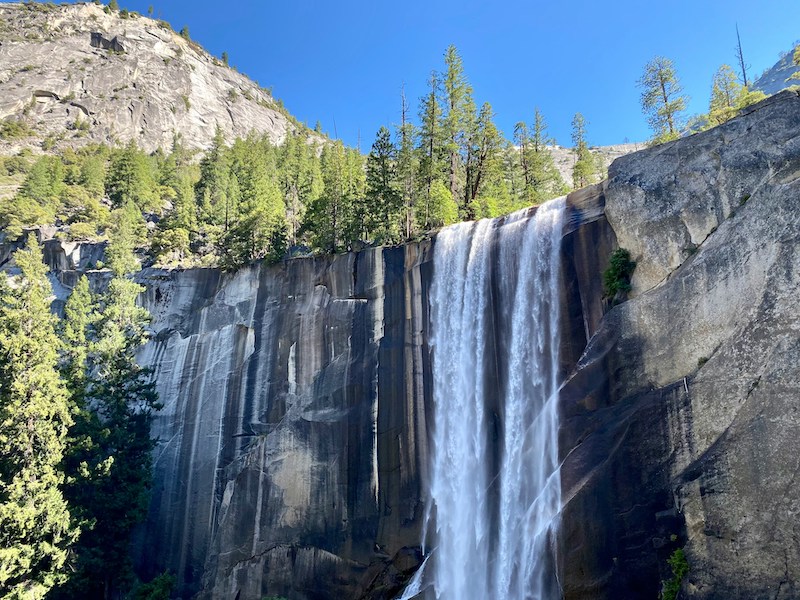
Vernal Fall is 317 feet tall and is just downstream of Nevada Fall. Both Vernal Fall and Nevada Fall can be seen from the legendary Mist Trail. If you choose to hike this trail, don’t forget a raincoat! Other great viewpoints of Vernal Fall include Washburn Point and Glacier Point.
The waterfall’s peak flow is in May. During the summer, the wide waterfall generally does not dry up but it does shrink and split into three different waterfalls as the water flow lessens. The water comes from the Merced River and creates what is called the “giant staircase.”
Nevada Fall
The taller of the two waterfalls at 594 feet, Nevada Fall is another spectacular sight. Thundering down the granite cliffs and into Yosemite Valley, Nevada Falls is just below the granite dome known as Liberty Cap. The water free falls off the cliff and creates the snowy white water.
Hiking up the Mist Trail, the brink of Nevada Fall is the end of the out and back trail with over 2,000 feet in elevation change.
Bridalveil Fall
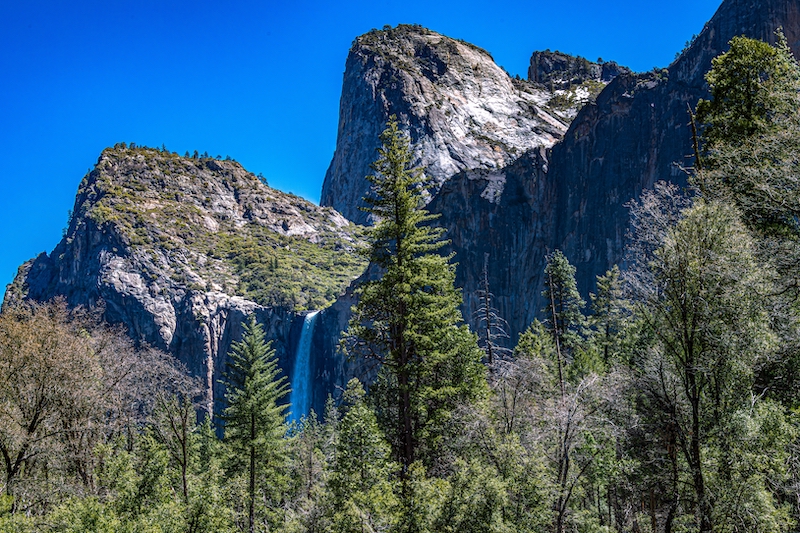
Bridalveil Fall is the first waterfall that greets you from the panoramic Tunnel View. At 620 feet, the waterfall is easily accessed via a newly paved trail to the base of the fall. The plunge can be seen throughout Yosemite Valley and gets its name from the mist that wafts off of it, clearly resembling a bride’s veil blowing in the breeze.
The waterfall flows all year long with the most impressive flow in May. While it does not dry up, the dry fall season reduces the waterfall to a wisp.
Ribbon Fall
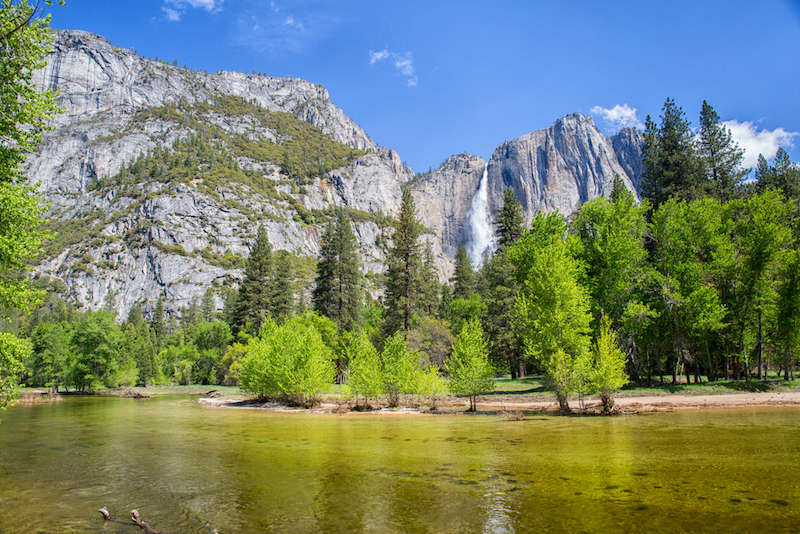
Ribbon Fall is one of the lesser known waterfalls. However, this fall is the tallest single-drop waterfall in North America. At 1,612 feet, this flow is fed by snowmelt and goes unnoticed by the majority of visitors. Once the snow melts in June, the waterfall dries up until the next year.
You can see Ribbon Fall to the west of El Capitan from the road as you drive into Yosemite Valley.
Seasonal Variations and Water Flow
There are a lot of considerations for planning your trip to Yosemite so that you get the most out of your trip. From seasonal water flow, to the changing foliage, to navigating spring and summer break, make sure to understand the seasonal variations to maximize your experience.
Spring Thaw and Peak Flow
Most of the water flows through the waterfalls due to snow melt and water runoff. As the winter snows melt and run into streams, the streams swell and increase the amount of water flowing through the falls. This is why the spring is the best time to view waterfalls.
Spring break is perfect for a family trip to see the falls and enjoy time with your kids. But, we recommend you avoid gift shop drama—grab a Yosemite National Park T-shirt from National Parks Supply Co. ahead of time and skip the stuffed bear meltdown
Summer Ebb and Reduced Flow
Summer is a dry time in California. Once the snow melts for the season, there is not typically additional rainfall to replenish the streams and rivers. Some waterfalls dry up and others just reduce in size while the park attendance swells. You might want to skip Yosemite in the summer if you’re looking for waterfalls.
Winter Freeze and Ice Formations
Winter brings snow and rain. As temperatures drop, there may be some water running through the waterfalls. This water can freeze and create beautiful ice formations. Yosemite Falls is one example: the base of Upper Yosemite Fall accumulates a cone of ice. The height can reach as high as 322 feet but melts by mid-April.
Frazil ice is another formation that occurs in waterfalls and creeks when the mist from the waterfall is very cold. Ice crystals form in the air and fall to the ground or creek below. It looks like slush or slurry and can back up, making a levee or clog up channels.
Autumn Colors and Waterflow
In the fall, do not expect to see much from the waterfalls. Yosemite Falls is often referred to as “Yosemite Walls” because the snowmelt from Yosemite Creek is non-existent. Many waterfalls reduce in size greatly.
However, Yosemite is a beautiful place to visit in the fall. Expect to see vibrant yellow from the Big Leaf maples and deep red from Dogwood trees. Late October will yield the most color and the park is still open for hiking. Trails will be less full after the busy summer and temperatures moderate. Fall is also popular for rock climbing, expect to see many expert climbers scaling El Capitan.
Best Times and Conditions for Viewing
Ideal Viewing Months
The ideal months to view Yosemite waterfalls are March through June. Peak snowmelt is in May, so expect waterfalls to be swollen and rushing with power during this month. Early spring could possibly be too cold, so keeping an eye on the weather is a good choice. A late spring thaw could also mean that June will still have strong water flow.
In the spring, watch out for flooding rivers. Since water is at the highest level, some banks might not contain the water flow.
Time of Day for Optimal Views
The best time of day to visit the waterfalls in Yosemite are early morning or late afternoon. There are less crowds than mid day and it provides the best light for photos as well.
Weather and Its Impact on Visibility
Every national park visit is dependent on the weather. Visiting Yosemite during a rain or in the winter can be tricky due to slippery trails.
In fact, any waterfall trail is bound to have slippery parts because of the waterfall spray. Check the weather ahead of time to be sure that you have the appropriate gear and wear boots with good traction and pack a raincoat. Yosemite can get spring rains, so checking ahead of time is a must do.
Hiking Trails and Accessibility
Yosemite Falls Trail
There are two trails with the name Yosemite Falls in it. Lower Yosemite Falls Trail is a one mile loop at the base of the waterfall. It leads close to the base of falls and the trail is paved, wheelchair accessible and you have a great view of the lower portion of Yosemite Falls. The trail is great for strollers and families. If you’re taking the shuttle, look for stop #6.
Mist Trail to Vernal and Nevada Falls
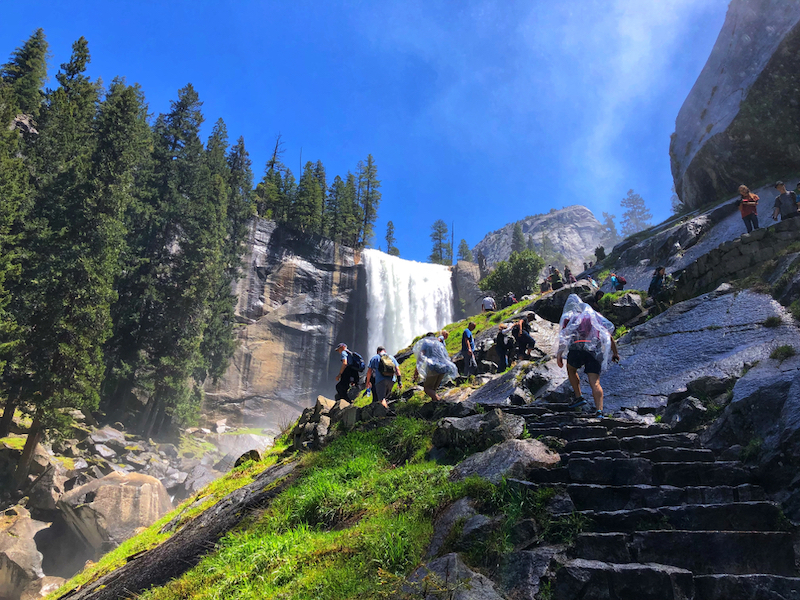
The Mist trail to see both Vernal and Nevada Falls is a must do for those who absolutely love waterfalls. The trail is approximately 6 miles long and has amazing views most of the way. The trail starts out as a leisurely walk but quickly progresses with some steep sections.
Expect to get misted with spray as you get close to both of the gorgeous waterfalls, so bring rain gear. The hike is classified as moderate and is quite popular, so plan on sharing the trail with others. If you make it to the end, you’ll be rewarded with striking views of the Nevada Fall, Liberty Cap, and the back of Half Dome.
Bridalveil Fall Trail
More of a walking path, Bridalveil Fall Trail is a 0.8 out and back trail. It’s very popular and great for families and wheelchairs. Bridalveil Fall is the first waterfall you see when entering Yosemite Valley. It flows year round, thundering in the spring and a wisp in the fall.
There are many viewpoints with beautiful views along the Yosemite Valley. The trail ends near the bottom of the waterfall and can get slippery with the mist.
Accessibility for Families and People with Disabilities
Yosemite declares that the park is committed to providing the highest level of accessibility to their visitors as possible. The park provides an extensive accessibility guide, a deaf services program and a Junior rangers program adapted for children with diverse communication, learning, motor and/or sensory needs.
The park has free shuttle buses, all equipped with wheelchair lifts and tie-downs. The park also has wheelchairs for rent. The Yosemite Falls Lower Trail, Bridalveil Falls Trail, Mirror Lake Trail are all paved and accessible.
Photography Tips for Capturing Waterfalls
Best Equipment and Settings
In order to get the silky smooth waterfall images, a tripod is a must. A high quality camera with the ability to control shutter speed is necessary along with a wide angle lens.
You’ll want to get the landscape in sharp focus, then adjust settings to let the water become blurred. This is done by using a longer shutter speed. This can be accomplished by setting the shutter priority or the aperture priority.
Composition and Framing Techniques
The composition of your photo is the difference between an okay image and a great one. Move the camera location around the waterfall to find the best scene. Remember the rule of thirds, look for how the water might form leading lines, and contemplate how the foreground elements will frame the waterfall by the scene around it.
Be sure to avoid bright regions, a blue sky, or sunny corners which can over expose the photo.


